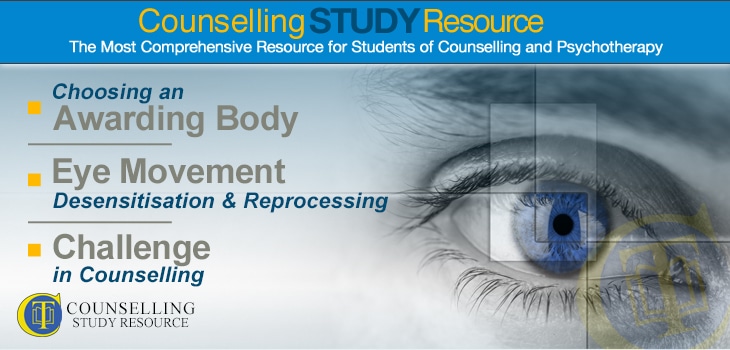043 – Choosing an Awarding Body – Eye Movement Desensitisation and Reprocessing – Challenge in Counselling
In episode 43 of the Counselling Tutor Podcast, Rory Lees-Oakes and Ken Kelly talk about how to choose which awarding body to go with for your qualification. ‘Theory with Rory’ explains about the new therapy of eye movement desensitisation and reprocessing (EMDR). Last, the presenters discuss the skill of challenge in counselling and psychotherapy.
Choosing an Awarding Body (starts at 3.50 mins)
Awarding bodies are exam boards; they are independent businesses set up to provide specifications for – and to award – qualifications. In England, syllabuses for qualifications that will be studied in publicly funded schools and colleges must be approved by the government body Ofqual. Examples of awarding bodies in the field of counselling include ABC, CPCAB and AIM Awards. Universities are outside Ofqual’s remit, as they can approve their own qualifications.
Like other qualifications, each counselling course equates to a level on the National Qualifications Framework – for example, a level 2 certificate is equivalent to GCSE level, a level 3 to A level, and a level 4 to the first year of a foundation degree. Level 4 is the minimum level of training you need to be a qualified counsellor, but not all level 4 courses qualify you as a counsellor. For example, they must include at least 100 hours of supervised practice with clients.
When you are choosing which counselling course to take, Rory and Ken advise contacting the relevant professional body – for example, the British Association of Counselling and Psychotherapy (BACP), National Counselling Society or Counselling & Psychotherapy in Scotland – to check that the course you’re looking at meets their requirements.
Some courses are BACP-accredited and some are not – if yours is not, it simply means that you will need to take the BACP Certificate of Proficiency after you have finished your qualification.
Eye Movement Desensitisation and Reprocessing (starts at 16.20 mins)
EMDR is a fascinating new therapy that helps people deal with post-traumatic stress disorder (PTSD) – which is when someone replays thoughts or feelings of a past traumatic event. For example, someone who has experienced being in a war zone may react to loud bangs in everyday life; they may even dissociate, feeling that they really are back in the dangerous place where they became traumatised. EMDR is used in the NHS. Rory explains the process of this therapy by using the analogy of moving memories from your camera’s memory card to your computer’s hard drive.
EMDR was developed by US psychologist Francine Shapiro, who noticed that when people moved their eyes in different directions, they processed information differently. EMDR is a way of moving traumatic information from the part of the brain that gives us strong emotions (the limbic system) to the part that allows us to look at information more rationally (the cerebral cortex). Whereas treating trauma used to require the person to relive the traumatic events (which could retraumatise them), EMDR does not require them to look at the detail of the events.
The process of EMDR has eight key stages:
- History and treatment planning – in this, the therapist builds rapport, working with the client to see how the traumatic events have altered their behaviours, and to identify the targets for treatment.
- Preparation – the therapist shows the client how to use certain techniques (e.g. visualisation, breathing and relaxation exercises) to help them from becoming restressed.
- Assessment – the client identifies and verbalises a statement that expresses a negative self-belief.
- Desensitisation – this uses the SUDS (subjective units of distress) scale to measure how badly the negative thoughts re-emerge.
- Installation – this can be compared to installing a new operating system on a phone or computer. It aims to increase the strength of positive beliefs.
- Body scan – the client is talked through how to check whether the new positive thinking is working.
- Closure – the therapist ensures that the client is safe to be sent back into the outside world, using breathing techniques etc.
- Re-evaluation – the client is reminded that their situation has changed. Their SUDS score would be expected to have declined, and their VOC (validity of cognition) score increased.
Challenge in Counselling (starts at 33.55 mins)
Some person-centred counsellors believe that challenging is inappropriate in this modality, but Ken and Rory believe it can be very powerful so long as it is done thoughtfully, supportively and from the client’s frame of reference. Many other modalities – including REBT and CBT, transactional analysis and Gestalt therapy – also use challenge to help bring about therapeutic change.
If you feel uncomfortable with challenging clients, you may like to explore in personal development what it is that makes you uneasy about this.
For more information on challenging:
- watch this lecture by Rory on challenging
- read Ken’s book, Basic Counselling Skills, in which a whole chapter is dedicated to the skill of challenge.


